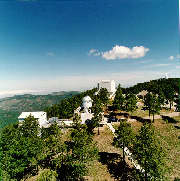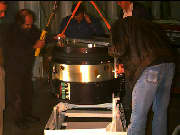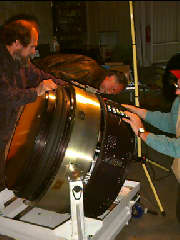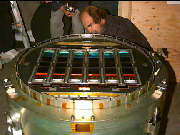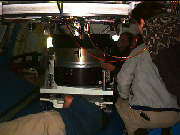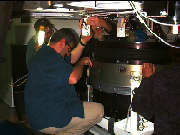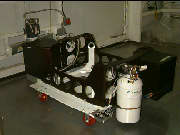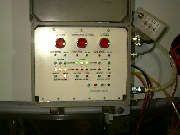Photos of the Sloan Digital Sky Survey at Apache Point Observatory, NM.Bartoszek Engineering has contributed to the Sloan Digital Sky Survey in several areas. The first job we did was to re-engineer the instrument latches that support the world's largest camera on the Sloan 2.5 meter telescope. The camera is a large CCD camera created by Dr. Jim Gunn and his design group at Princeton University. The latches are pneumatically actuated hooks that allow the camera to be mounted and dismounted from the telescope several times in one night. They must work 100% reliably or they jeopardize the safety of the >$4M camera. Bartoszek Engineering took the original latch design created by another party which did not work and redesigned them to support 700 lbs each and be able to cycle >10,000 times at 100% reliability. All but the first two photos below were taken by Gretchen Van Doren of Apache Point Observatory. They appeared originally on the APO web site but have since been removed. The first two come from Fermilab Media Services. If you would like to learn more about astronomy and astronomers, telescopes, CCD cameras and the Princeton design team, I highly recommend Richard Preston's book "First Light--The search for the edge of the universe". You are welcome to download any of the images. If they are used for other than private viewing, credit to Bartoszek Engineering, Apache Point Observatory, or Fermilab would be appreciated. (Presentation of photos from Fermilab does not imply endorsement of any product or service.) Link to the report on the performance of the belleville springs in the camera latches Link to the report on the life testing of the camera latches Link to the report on the cleaning of the rotator bearing
This picture shows the site layout of Apache Point Observatory. There are several telescopes visible. In the background is the 3.5 meter telescope and a smaller one, and in the foreground is the .6 meter monitor telescope and the 2.5 meter Sloan Digital Sky Survey telescope. The monitor telescope will monitor atmospheric conditions while the Sky Survey is progressing to make corrections possible.
This picture shows how the 2.5 meter telescope is mounted on the side of a mountain overlooking Alamagordo, New Mexico, and the White Sands Missile Range (in the background). The building in the foreground is mounted on rails and is pulled off the telescope for viewing and back on for stowing the telescope during bad weather.
The latches are the rectangular objects surrounding the circular opening in the bottom of the telescope. (The hole is partially blocked by an alignment fixture used to position the latches.) The hole is where the light gathered by the 2.5 m telescope's mirrors enters the camera. The disk that the latches are mounted on is called the "instrument rotator". The Sloan telescope is an alt-az mounting (altitude-azimuth), meaning it has a vertical rotation axis (the azimuth axis) and a horizontal one (the altitude axis). This arrangement differs from an equatorial mounted telescope in that when it tracks the motion of the stars throughout the night the image seen by the camera rotates. This rotation is corrected for by rotating the camera on the instrument rotator by an equal amount.
This view has the assembly fixture removed from the opening in the instrument rotator. Through the hole two members of the Princeton design group can be seen.
This picture was taken shortly after the camera was unpacked at APO and readied to attach to the service cart. Jim Gunn is operating the crane while Mike Carr (back to the camera) checks the camera's alignment to the cart. As later pictures will show, the camera is supported by the service cart until it is lifted up to the instrument rotator and fastened to the telescope with the latches.
The service cart allows the camera to be rotated about its center of mass so that work can be performed on either the top or the bottom of the camera.
This picture shows the end of the camera that collects the starlight sent to it by the telescope's mirrors and converts it to electrical signals in the CCD chips. The colored squares are filters that allow different colors of starlight to fall on different CCD chips. The CCDs (charge-coupled devices) are silicon semiconductor chips that are extremely sensitive to light. They are cooled to liquid nitrogen temperature to reduce noise and improve their sensitivity. The Sloan camera is not intended to take still pictures of the night sky, but is a drift camera that records swaths of sky in continuous motion.
A view of the bottom side of the Sloan CCD camera. The plumbing is to feed liquid nitrogen to the CCD chips. The camera will put out an enormous datastream while recording the sky, which is why its data acquisition system was designed by Fermilab. The datastream from the camera is similar in volume and rate to that in a typical high energy physics experiment, and much greater than previously collected in astronomical observation.
This picture shows the first time the camera was placed on the instrument lift, getting ready for its first attachment to the telescope. There are features on the service cart that align the camera to the instrument lift and telescope. During normal operation, the camera will live in an enclosure called the "doghouse" and be rolled on its service cart to the telescope as needed. The instrument lift is a hydraulic elevator that lifts the camera into position on the instrument rotator.
During the first mating of the telescope and camera several alignment features were found to be out of proper placement and we were forced to manually align the camera and telescope using rulers taped to the latches. These acted as guides so we could properly place the camera and then correct the alignment features.
This picture shows the very first time the Sloan camera was mated to the 2.5 m telescope. You can see the instrument lift under the service cart in the foreground. We need to make this operation as easy and automatic as possible because of the number of times a night the camera may be mounted and dismounted during the survey.
This image shows the camera saddle mounted on the service cart. The saddle holds liquid nitrogen dewars and routes much of the plumbing and wiring of the camera to the outside world. In normal operation the camera and saddle will always be moved together on the same cart.
The Fermilab-designed latch control panel sends signals to and receives signals from the Motion Control computer. When the computer determines that it is time to change the state of the latches it will light certain lights on the panel. A person must then push the button releasing the final manual pneumatic valve which causes the latch to change state. In this way unforeseen mistakes on the part of the MCP will hopefully be avoided by the required human intervention.
Back to the Bartoszek Engineering Projects Page
Back to the Bartoszek Engineering Home Page
|
